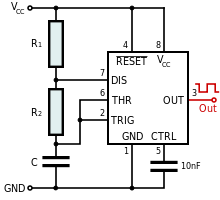The first scheme is the astable configuration as descibed by the datasheet: it's a monostable multivibrator which triggers itself.
- When the output is low, C is charged through R1 and R2 until it reach the threshold voltage (2/3 Vcc);
- then OUT is turned high, DIS is turned on and the capacitor starts discharging through R2 to DIS, until it drops below the triggering voltage (1/3 Vcc); then OUT goes low and it starts again.
Note that the duty cycle is limited to 1/2.
The other two schemes have the advantage that the duty cycle can go from almost 0 to almost 100%, making them more suitable for PWM purposes.
The second schematic is very ugly, but basically you change the duty cycle varying the ratio of the resistances that charge and discharge the capacitor C1, turning the potentiometer R1.
For some reason, the charge and discharge of C1 is driven by the output Q, while the real output is through the DIS pin. The bad thing about this is that the output through the DIS pin is open collector, so it will be strongly driven low by the Dis pin but pulled up only by the 10k resistor.
Note that if you turn it fully to one of the rails, you are basically charging/discharging the capacitor through a diode and the output stage of the 555. This is not exactly a good idea.
The third one is based on the same concept, but a resistor is put to the OUTput to avoid the aforementioned problem, and the Vout pin is used properly.
If you need a PWM control, I would suggest looking at the datasheet, where you can find a good PWM modulator:






